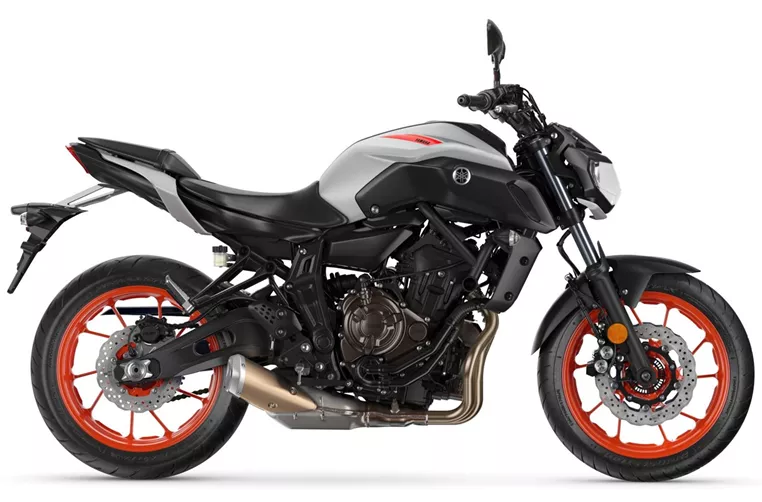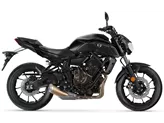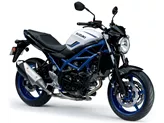Kawasaki Z 750R 2011 vs. Yamaha MT-07 2020

Kawasaki Z 750R 2011

Yamaha MT-07 2020
Overview - Kawasaki Z 750R 2011 vs Yamaha MT-07 2020
The Kawasaki Z 750R 2011 and the Yamaha MT-07 2020 are both naked bikes that offer different features and specifications.
Starting with the engine and drive train, the Kawasaki Z 750R 2011 is equipped with an in-line four-cylinder engine that delivers 106 horsepower and 78 Nm of torque. On the other hand, the Yamaha MT-07 2020 comes with an in-line two-cylinder engine that produces 75 horsepower and 68 Nm of torque. While the Kawasaki Z 750R has more power, the Yamaha MT-07 compensates with a high-torque engine that provides a smooth and enjoyable riding experience.
In terms of cooling, both bikes have liquid-cooled engines, ensuring optimal performance and preventing overheating. They also have similar displacement, with the Kawasaki Z 750R having a 748ccm engine and the Yamaha MT-07 having a slightly smaller 689ccm engine.
Moving on to the suspension, the Kawasaki Z 750R 2011 features an upside-down telescopic fork in the front, providing better stability and handling. The Yamaha MT-07 2020, on the other hand, has a telescopic fork in the front. While both suspension systems offer decent performance, the upside-down fork on the Kawasaki Z 750R may provide better control during aggressive riding.

Kawasaki Z 750R 2011
In terms of chassis, both bikes have steel frames, ensuring durability and stability. This allows for a comfortable and secure riding experience on various terrains.
When it comes to braking, both bikes are equipped with double disk brakes in the front, providing excellent stopping power and control. This is a crucial feature for safety, especially during high-speed riding or sudden stops.
In terms of dimensions and weights, the Kawasaki Z 750R 2011 has a slightly longer wheelbase of 1440mm compared to the Yamaha MT-07 2020's 1400mm. The seat height of the Kawasaki Z 750R is also higher at 835mm, while the Yamaha MT-07 has a lower seat height of 805mm. Additionally, the Kawasaki Z 750R is heavier, with a kerb weight of 227kg (230kg with ABS), compared to the Yamaha MT-07's lighter 179kg (182kg with ABS).

Yamaha MT-07 2020
Lastly, the fuel tank capacity of the Kawasaki Z 750R is larger at 18.5 liters, providing a longer range between refueling. The Yamaha MT-07 has a smaller fuel tank capacity of 14 liters.
In terms of strengths, the Kawasaki Z 750R 2011 offers a confident engine performance, excellent braking system, and the added safety feature of ABS. On the other hand, the Yamaha MT-07 2020 boasts a high-torque two-cylinder engine, a well-done chassis set-up, and a pleasant seating position. It also offers a large selection of accessories and a competitive price-performance ratio.
However, the Kawasaki Z 750R 2011 does have a weakness in terms of stability, with some reports of unsteadiness in the chassis. On the other hand, the Yamaha MT-07 2020 has been criticized for its optics and fittings, which some may find to look a bit dull or cheap. Additionally, some riders have mentioned that the controls on the handlebars of the Yamaha MT-07 feel a little cheap.
In conclusion, both the Kawasaki Z 750R 2011 and the Yamaha MT-07 2020 offer their own unique features and strengths. The Kawasaki Z 750R excels in engine power and braking performance, while the Yamaha MT-07 shines with its high-torque engine, comfortable riding position, and attractive price-performance ratio. Ultimately, the choice between the two will depend on the rider's preferences and priorities.
Technical Specifications Kawasaki Z 750R 2011 compared to Yamaha MT-07 2020
Pros and Cons in comparison
Pros and Cons in comparison
Kawasaki Z 750R 2011

All in all, we think the Kawasaki Z 750 is right to wear the R. It is definitely a lot of fun on trackdays. However, if you want to hunt for lap times energetically, you have to invest in the chassis. Primarily to gain lean angle clearance. After that, you could even think about an "RR" in the name abbreviation.
Yamaha MT-07 2020

The MT-07 is a wonderful fun machine that is extremely sporty to ride. The brakes pack a punch and the engine is currently by far the most agile powerplant in this class - and perhaps even above. The light handling fits in perfectly and the chassis makes the understandable compromise between comfort and sport - reminding us that the affordable MT-07 should also have a lot to offer beginners. Only the design with halogen headlights and conventional forks is rather old-fashioned.
Price Comparison Avarage Market Price Kawasaki Z 750R vs Yamaha MT-07
There are a few key differences between a Kawasaki Z 750R 2011 and a Yamaha MT-07 2020. In terms of price, the actual average price of a Yamaha MT-07 2020 is about 33% higher. Compared to Yamaha MT-07 2020 there are less Kawasaki Z 750R 2011 bikes available on the 1000PS.de Marketplace, specifically 4 compared to 20. It takes less time to sell a Kawasaki Z 750R with 49 days compared to 69 days for a Yamaha MT-07. Since model year 2011 1000PS.de editors have written 7 reviews for the Kawasaki Z 750R and 69 reviews for the Yamaha MT-07 since model year 2013. The first review for the Kawasaki Z 750R was published on 9/14/2010 and now has more than 17,800 views. This compares to more than 12,600 views for the first review on Yamaha MT-07 published on 11/4/2013.
































